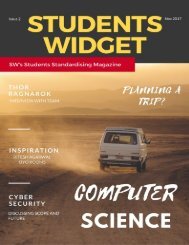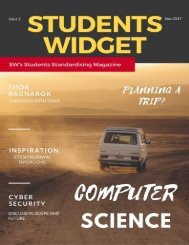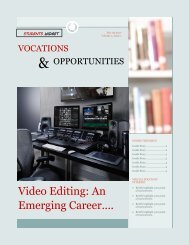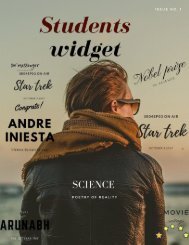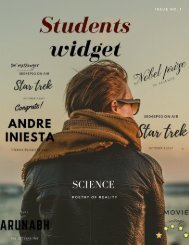3issue3
Create successful ePaper yourself
Turn your PDF publications into a flip-book with our unique Google optimized e-Paper software.
Students widgets<br />
New technique allows rapid<br />
screening for new types of solar<br />
cells<br />
Approach could bypass the time-consuming steps currently needed to test<br />
new photovoltaic materials.<br />
The worldwide quest by researchers to find better, more efficient materials<br />
for tomorrow’s solar panels is usually slow and painstaking. Researchers
Students widgets<br />
typically must produce lab samples — which are often composed of multiple<br />
layers of different materials bonded together — for extensive testing.<br />
Now, a team at MIT and other institutions has come up with a way to bypass<br />
such expensive and time-consuming fabrication and testing, allowing<br />
for a rapid screening of far more variations than would be practical through<br />
the traditional approach.<br />
The new process could not only speed up the search for new formulations,<br />
but also do a more accurate job of predicting their performance, explains<br />
Rachel Kurchin, an MIT graduate student and co-author of a paper describing<br />
the new process that appears this week in the journal Joule. Traditional<br />
methods “often require you to make a specialized sample, but that differs<br />
from an actual cell and may not be fully representative” of a real solar cell’s<br />
performance, she says.<br />
This experimental setup was used by the team to measure the electrical<br />
output of a sample of solar cell material, under controlled conditions of varying<br />
temperature and illumination. The data from those tests was then<br />
used as the basis for computer modeling using statistical methods to predict<br />
the overall performance of the material in real-world operating conditions.
Students widgets<br />
Study boosts hope for cheaper fuel cells<br />
Researchers show how to optimize nanomaterial for fuel-cell cathodes<br />
Simulations by scientists show how carbon nanomaterials may be optimized<br />
to replace expensive platinum in cathodes for electricitygenerating<br />
fuel cells<br />
Simulations by Rice University scientists show how carbon nanomaterials may be<br />
optimized to replace expensive platinum in cathodes for electricity-generating fuel<br />
cells for transportation and other applications.<br />
Credit: Yakobson Research Group/Rice University<br />
Nitrogen-doped carbon nanotubes or modified graphene Nano ribbons may be<br />
suitable replacements for platinum for fast oxygen reduction, the key reaction in<br />
fuel cells that transform chemical energy into electricity, according to Rice University<br />
researchers.<br />
The findings are from computer simulations by Rice scientists who set out<br />
to see how carbon nanomaterials can be improved for fuel-cell cathodes.<br />
Their study reveals the atom-level mechanisms by which doped nanomaterials<br />
catalyze oxygen reduction reactions (ORR).
Students widgets<br />
The Rice researchers, including lead author and former postdoctoral associate<br />
Xiaolong Zou and graduate student Luqing Wang, used computer<br />
simulations to discover why graphene nanoribbons and carbon nanotubes<br />
modified with nitrogen and/or boron, long studied as a substitute for expensive<br />
platinum, are so sluggish and how they can be improved.<br />
Doping, or chemically modifying, conductive nanotubes or nanoribbons<br />
changes their chemical bonding characteristics. They can then be used as<br />
cathodes in proton-exchange membrane fuel cells. In a simple fuel cell, anodes<br />
draw in hydrogen fuel and separate it into protons and electrons.<br />
While the negative electrons flow out as usable current, the positive protons<br />
are drawn to the cathode, where they recombine with returning electrons<br />
and oxygen to produce water.<br />
The models showed that thinner carbon nanotubes with a relatively high<br />
concentration of nitrogen would perform best, as oxygen atoms readily<br />
bond to the carbon atom nearest the nitrogen. Nanotubes have an advantage<br />
over nanoribbons because of their curvature, which distorts chemical<br />
bonds around their circumference and leads to easier binding, the researchers<br />
found.<br />
The tricky bit is making a catalyst that is neither too strong nor too weak as<br />
it bonds with oxygen. The curve of the nanotube provides a way to tune<br />
the nanotubes' binding energy, according to the researchers, who determined<br />
that "ultrathin" nanotubes with a radius between 7 and 10 angstroms<br />
would be ideal. (An angstrom is one ten-billionth of a meter; for<br />
comparison, a typical atom is about 1 angstrom in diameter.)<br />
They also showed co-doping graphene nanoribbons with nitrogen and boron<br />
enhances the oxygen-absorbing abilities of ribbons with zigzag edges.<br />
In this case, oxygen finds a double-bonding opportunity. First, they attach<br />
directly to positively charged boron-doped sites. Second, they're drawn by<br />
carbon atoms with high spin charge, which interacts with the oxygen atoms'<br />
spin-polarized electron orbitals. While the spin effect enhances adsorption,<br />
the binding energy remains weak, also achieving a balance that<br />
allows for good catalytic performance.<br />
The researchers showed the same catalytic principles held true, but to<br />
lesser effect, for nanoribbons with armchair edges.
Students widgets<br />
Making solar energy more efficient<br />
With global warming an ever-present worry, renewable energy -- particularly solar<br />
power -- is a burgeoning field. Now, two doctoral students in the School of Architecture<br />
& Design (Arc/D) have demonstrated methods of optimizing the capture of<br />
sunlight in experiments at the Center for Design Research.<br />
Green-roof boost<br />
Mohammed Alshayeb started by asking himself what might be done to boost the<br />
performance of solar panels. "The efficiency of a photovoltaic panel is measured<br />
under standard testing conditions -- at 77 degrees Fahrenheit," he said. "Every degree<br />
that the temperature increases decreases performance."<br />
Alshayeb wondered if there was a way to "extract the heat out of the panels" when<br />
the temperature rises above 77. Because most solar panels are installed on building<br />
roofs, Alshayeb decided to compare the effects of three different types of roof<br />
materials -- highly reflective (i.e., white), conventional (black) and vegetated<br />
(green) -- on the panels' performance.<br />
The CDR roof is mostly covered with sedum, planted in trays. So Alshayeb established<br />
his test bed there, installing a solar panel monitoring system over the green<br />
roof, as well as nearby white and black portions. He also installed temperature, humidity<br />
and light sensors and a weather station to record conditions like wind speed.<br />
The sensors made recordings every five minutes for a year, and Alshayeb then analyzed<br />
the data.
Students widgets<br />
What he found was that, contrary to industry practice, which favors white<br />
roofs over black, white roofs actually slightly decreased the efficiency of the<br />
solar panels due to the heat they reflected up toward the panels. However,<br />
compared to the vegetated roof, the high-reflective and conventional roof<br />
materials were not significantly different from one another. Panels installed<br />
over the green roof performed best, generating an average of 1.4 percent<br />
more energy as compared to those over the white and black roofs.<br />
Bending light<br />
Another of Chang's students, Afnan Barri, wanted to see whether she could<br />
improve the performance of light shelves. A traditional light shelf is a fixed,<br />
horizontally mounted plane that can be placed either outside, inside or on<br />
both sides of a window in order to reflect and redirect sunlight inside a<br />
building. Light shelves can thus reduce the use of artificial lighting and<br />
electricity.<br />
Traditional, fixed light-shelf systems have limited effectiveness, as they are<br />
only capable of functioning while the angle of the sun to the earth is just<br />
right. Previous experiments have shown that movable light shelves and<br />
ones with curved surfaces can diffuse sunlight with greater efficiency than<br />
traditional fixed, flat systems. This is where Barri's idea of a Dynamic Thermal-Adaptive<br />
Curved Lightshelf (DTACL) came about. She thought: "What<br />
if there were a system that could combine all these methods to enhance<br />
the delivery of natural light into buildings throughout the day without the<br />
use of mechanical and electrical controls, and unlike existing movable systems?"<br />
Her project includes computer simulations and a field experiment to collect<br />
a year's worth of data on the performance of the DTACL system through<br />
different weather conditions on the KU campus. She created and placed on<br />
the lawn of the CDR four experimental rooms the size of refrigerators fitted<br />
with sensors and light shelves. Three of the rooms have fixed light shelves<br />
in various configurations, while one, the DTACL, uses an adaptive, composite<br />
material called Thermadapt, invented by Ronald P. Barrett and commercialized<br />
by a company he runs with his son, KU Professor of Engineering<br />
Ron Barrett-Gonzalez. Thermadapt changes shape in response to heat<br />
and sunlight, curving upward. When it cools, it flattens back out.<br />
Barri theorized that the DTACL system would transfer light inside a building<br />
more efficiently than the fixed systems, and her initial results have proven<br />
that to be the case.
Students widgets<br />
Capturing the properties of very<br />
hot compounds<br />
MIT researchers demonstrate a new electrochemical method to study thermodynamic<br />
processes in an ultra-high temperature molten oxide.<br />
The thermodynamic properties of compounds such as aluminum oxide, which<br />
are known as refractory materials because they melt at temperatures above<br />
2,000 degrees Celsius (3,632 Fahrenheit), have been difficult to study because<br />
few vessels can withstand the heat to contain them, and those that do<br />
often react with the melt and contaminate it.<br />
Now MIT researchers are showcasing a container-less electrochemical method<br />
to study the thermodynamic properties of these hot melts in<br />
a paper published in the Journal of The Electrochemical Society.<br />
“We have a new technique which demonstrates that the rules of electrochemistry<br />
are followed for these refractory melts,” says senior author Antoine Allanore<br />
, an associate professor of metallurgy. “We have now evidence that these<br />
melts are very stable at high temperature, they have high conductivity.”
Students widgets
Students widgets<br />
The greatest showman<br />
STORY: The period musical drama is<br />
based on the life and times of 19th<br />
-century showman PT Barnum,<br />
who founded the famous Barnum<br />
and Bailey Circus.<br />
8/10<br />
Star Cast:<br />
Hugh Jackman, Michelle Williams,<br />
Zack Efron<br />
Director:<br />
Michael Gracey<br />
Writers:<br />
Jenny Bicks (screenplay by), Bill<br />
Condon (screenplay by)<br />
REVIEW: The film tells Barnum's<br />
|<br />
rags to riches story and explores<br />
how his meteoric rise to fame and fortune was muddled<br />
with allegations of exploiting the disabled for<br />
his circus. However, many also argued that his vision<br />
unified the outcasts and acknowledged their existence<br />
when their own disowned them.
Students widgets<br />
Must Watch TV Series<br />
Twin Peaks:<br />
The Return<br />
One wonder what<br />
must have gone<br />
through the minds of<br />
Showtime executives<br />
every week as another<br />
hour-long edition<br />
of David Lynch's truly<br />
mind-melting revival<br />
of his cultclassic<br />
ABC series<br />
aired to the confusion—yet<br />
delight—of<br />
its viewers. While no<br />
one quite knew what<br />
to expect from Twin<br />
Peaks: The Return, it's<br />
possible that a completely<br />
disjointed narrative,<br />
surprise celebrity cameos, and a talking brain on a stick<br />
were not exactly what anyone hoped for. While the new Twin<br />
Peaks dove right back into the larger mystery of Laura Palmer's<br />
murder—and spun wildly away from the town of Twin Peaks, with<br />
settings ranging from Manhattan to the flyover states—one thing<br />
is for certain: It is a damn miracle that David Lynch got full rein<br />
to do whatever the hell he wanted for a blissful 18 episodes.
Students widgets<br />
Big Little Lies<br />
David E. Kelly's adaptation of Liane Moriarty's novel could<br />
have been a by-the-book miniseries adaptation of a popular<br />
novel about wealthy women and their catty schemes (which<br />
end in a shocking murder). Under the direction of Jean-Marc<br />
Vallée, however (and with the brilliant performances from<br />
Reese Witherspoon, Nicole Kidman, Shailene Woodley, and<br />
Laura Dern), the miniseries was less your typical whodunit<br />
and more a moody satire of modern parenting and a disturbing<br />
take on the lengths to which domestic violence can penetrate<br />
a family's psyche. But as dark as it can be, the show<br />
was ultimately hugely satisfying, balancing the somewhat<br />
bleak tone with a heightened, comedic take on the lengths<br />
at which adults can exhibit the most immature, childlike<br />
traits.
Students widgets<br />
The Handmaid's Tale<br />
Hulu's serial adaptation of The Handmaid's Tale couldn't<br />
have come at a better time—even if it was in production<br />
well before the election results came in last November.<br />
While many have found many parallels between the<br />
American in which we live today and the fictional Republic<br />
of Gilead on the show, Margaret Atwood's dystopian<br />
tale of an ultra-patriarchal society—one that has forced<br />
the few remaining fertile women into a form of slavery,<br />
serving as surrogates for wealthy couples following a global<br />
natural disaster that left most women unable to conceive—would<br />
have seemed relevant and deeply troubling<br />
had Hillary Clinton become president, too, as The Handmaid's<br />
Tale'sthemes are universal and, unfortunately,<br />
timeless. The disturbing nature of the show aside, at<br />
least we can welcome the return of Elisabeth Moss to<br />
the small screen, playing yet another feminist icon in the<br />
starring role of Offred
Students widgets<br />
The Good Place<br />
Parks and Recreation co-creator Michael Schur<br />
built an incredible, wacky afterlife for his latest<br />
series, which fills the self-referential and absurdist<br />
void left open when Parks and Rec went off the<br />
air in 2015. When Eleanor (Kristen Bell) lands in<br />
the Good Place after her death, she immediately<br />
realizes there's been some bureaucratic mistake—<br />
but she intends to keep quiet in order to keep<br />
herself away from the Bad Place. Season One ended<br />
with a major twist that could have derailed<br />
the entire series, but the show's second season<br />
sees Schur and his writing staff brilliantly skewing<br />
the traditional sitcom format, delivering an impressively<br />
airtight and incredibly funny narrative<br />
each week. And alongside Bell, the show boasts a<br />
tremendous cast of talent including Ted Danson,<br />
William Jackson Harper, Jameela Jamil, Manny<br />
Jacinto, and breakout star D'Arcy Carden as Janet,<br />
the all-knowing concierge to the hereafter.
Students widgets
Students widgets<br />
Coutinho completes 160-million-euro<br />
Barcelona move<br />
Coutinho, 25, signed a fiveyear<br />
contract in a ceremony<br />
alongside Barca president<br />
Josep Maria Bartomeu<br />
BARCELONA: Philippe Coutinho officially joined Barcelona<br />
on Monday, completing a move from Liverpool thought<br />
to be worth 160 million euros ($192 million), making it<br />
the third richest transfer in history.<br />
Coutinho, 25, signed a five-year contract in a ceremony<br />
alongside Barca president Josep Maria Bartomeu.<br />
But minutes before he put pen to paper, the club said<br />
a thigh injury would delay his debut until the end of<br />
January.
Students widgets<br />
Real fall 16 points behind Barcelona<br />
after draw with Celta<br />
BARCELONA: Real Madrid's faltering title defence continued as they<br />
were held to a thrilling 2-2 draw at Celta Vigo on Sunday which<br />
saw them fall 16 points behind runaway leaders Barcelona, who<br />
beat Levante 3-0 to stay nine points clear at the top of La Liga.<br />
Real looked to be heading for a second successive league defeat after<br />
their 3-0 loss to Barca in their last outing when Daniel Wass<br />
lobbed over Keylor Navas to put Celta ahead in the 33rd minute.
Students widgets<br />
ICC Test rankings: Australia swap places<br />
with England after Ashes triumph<br />
Australia's innings and 123-run win over England on final<br />
day of the fifth and final Ashes Test have pushed<br />
them to third spot in the latest ICC team rankings.<br />
Australia have moved into third place while England<br />
have dropped to fifth position following the conclusion<br />
of the Ashes in Sydney today.
Students widgets<br />
Apple's legendary Lisa OS to be released for free<br />
AN FRANCISCO: The Computer History Museum in California has<br />
planned to release Apple's legendary Lisa operating system (OS) for<br />
free as open source this year, the media reported.<br />
The Mountain View-based museum announced that the source code<br />
for Lisa, Apple's computer that predated the Mac, has been recovered<br />
and was being reviewed by the tech giant itself, reports<br />
9to5Mac.<br />
Lisa, released in 1983, was one of the first personal computers to<br />
come equipped with a graphical user interface and a support for<br />
mouse, but ultimately only sold 10,000 units.<br />
"Just wanted to let everyone know the sources to the OS and applications<br />
were recovered, I converted them to Unix end of line conventions<br />
and spaces for Pascal tabs after recovering the files using Disk<br />
Image Chef, and they are with Apple for review," said Al Kossow, a<br />
software curator at the museum.<br />
"After that's done, the code that is cleared for release by Apple will<br />
be made available in 2018. The only thing I saw that probably won't<br />
be able to be released is the American Heritage dictionary for the<br />
spell checker in Lisa Write."<br />
The source code for both the OS and applications has been recovered.<br />
Once that code is finished being reviewed by Apple, the museum will<br />
make the code available sometime this year, Kossow added.
Students widgets<br />
CorrosionRADAR is a patented sensing system comprised of a thin long<br />
flexible sensor which can detect and locate corrosion in the most difficult,<br />
inhospitable and inaccessible environments including pipe racks,<br />
pipe bends, buried pipelines etc.<br />
Benefits: In comparison to other existing technologies in the market,<br />
CorrosionRADAR offers key advantages such as; inspection range of up<br />
to a kilometer, flexibility which enables the sensor to be used on flanges,<br />
pipe support or any other complex geometry, and finally its comparably<br />
low cost.<br />
Applications: One of the key advantages of the technology lies in<br />
its versatility and applicability to various industry sectors. Essentially<br />
wherever monitoring the corrosion & corrosion under insulation is required,<br />
CorrosionRADAR can provide cost effective, smart and environmental<br />
friendly solutions.
Students widgets<br />
Encryption, data<br />
and government:<br />
Lessons learned<br />
The KRACK vulnerability has been one of the many highly publicised cyber security<br />
weaknesses that are more frequently making it to the front pages of<br />
news papers and websites.<br />
KRACK or Key Reinstallation Attacks allow attackers to break the encryption<br />
that protects your traffic while traversing the air between your device and its<br />
connected wireless access point.<br />
The recent news and subsequent publicity around the KRACK vulnerability<br />
has meant that many more people now know what WPA2 (Wi-Fi Protected Access)<br />
is and the risks to their privacy and security when using Wi-Fi without<br />
encryption.<br />
Encryption is the key to keeping people safe online. Encryption is a mathematical<br />
formula that randomises data to make the original content unreadable<br />
to unauthorized parties. All most every commonly used encryption algorithm<br />
produces at least one string of numbers that can be used to decipher the data<br />
into its original legible form. This string of number is the key.
Students widgets<br />
The protection provided by a good encryption algorithm is its resistance to<br />
brute-forcing, a method of hacking by taking attempts at guessing the key. A<br />
key must be large enough so that an attacker or snooper cannot guess the<br />
combination of numbers in any reasonable amount of time. An additional<br />
method of protection comes from the algorithms resistance to cryptanalysis,<br />
the process of deciphering the encrypted message by analyzing the algorithm<br />
and its output.<br />
Every piece of data that is encrypted has it own randomized key that is required<br />
to reconstruct the original form. This means that even if a cybercriminal<br />
stole your businesses encrypted files it would potentially take them hundreds<br />
of years to crack each of the keys.<br />
The problem with forcing a change in standards is that they are currently set<br />
by the ISO (the International Organization for Standardization) who have already<br />
rejected new standards from the US intelligence agency, the NSA<br />
(National Security Agency), based on the fears of a hidden backdoor. Additional<br />
problems arise when you consider that the ISO do not enforce these<br />
standards and there is no global governmental organization that could do<br />
this. If an encryption backdoor is to be rolled out in a small selection of countries,<br />
criminal communications would be the least of the governments concerns<br />
as adversary governments shift all their cyber resources into exploiting<br />
this backdoor.<br />
Although KRACK might seem like a huge threat to our general security, it isn’t.<br />
Thanks to the responsible disclosure of the vulnerability, vendors have<br />
already taken affirmative action, and most have released a patch for affected<br />
devices.<br />
Its only effect on criminal organisations would be to drive them to use<br />
emerging technologies that are more secure, more undetectable and far<br />
less understood. There is no patch or easily followed advice for this, the<br />
damage would be permanent, and the solution would end up making<br />
the problem worse.
Students widgets<br />
An in-screen fingerprint sensor will be a real<br />
thing in 2018<br />
On December 12, Synaptics (one of the biggest names in the biometric<br />
industry) announced that it was finally ready to start mass-producing<br />
the first-ever fingerprint sensor that's hidden underneath a<br />
smartphone display.<br />
Synaptics is using its new Clear ID FS9500 sensor to make this all<br />
possible, and according to Forbes reporter Patrick Moorhead, using<br />
the new sensor is "fast and simple." The sensor doesn't actually turn<br />
on until you're ready to use it to help conserve battery life, and when<br />
you do go to unlock your phone, you'll see a fingerprint icon near the<br />
bottom of your phone's display.<br />
Just put your finger on this icon (that OEMs can customize the look of) and your<br />
phone will be unlocked with the same level of security and convenience we've<br />
come to expect from sensors on current handsets.
Students widgets<br />
The World’s<br />
First Robot<br />
Citizen :Sophia<br />
(robot)<br />
Sophia is a social humanoid<br />
robot developed by Hong<br />
Kong-based company<br />
Hanson Robotics. Sophia<br />
was activated on April 19,<br />
2015 *1+ and made her first<br />
public appearance at South<br />
by Southwest Festival<br />
(SXSW) in mid-March<br />
2016 in Austin, Texas, United<br />
States *2+ . She is able to display<br />
more than 62 facial expressions.<br />
Sophia has been covered by<br />
media around the globe and<br />
has participated in many<br />
high-profile interviews. In<br />
October 2017, the robot became<br />
a Saudi Arabian<br />
citizen, the first robot to<br />
receive citizenship of any country. In November<br />
2017, Sophia was named<br />
the United Nations Development Programme's<br />
first ever Innovation Champion,<br />
and the first non-human to be given<br />
any United Nations title.<br />
Features: Cameras within her eyes<br />
combined with computer algorithms allow<br />
Sophia to see. She can follow faces, sustain<br />
eye contact, and recognize individuals. She<br />
is able to process speech and have conversations<br />
using Alphabet’s Google Chrome<br />
voice recognition technology and other<br />
tools
Students widgets<br />
Asus ROG Strix Hero edition review: The<br />
working class hero
Students widgets<br />
Amazon Echo Plus Review:<br />
The digital personal assistant everyone
This editon included<br />
all the<br />
trending stuffs<br />
relatd to the<br />
computer science<br />
field in the particular<br />
published<br />
week<br />
Email- studentswidget@gmail.com<br />
Info– www.studentswidget.xyz





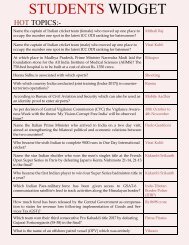
![crnt[1]](https://img.yumpu.com/59512911/1/190x245/crnt1.jpg?quality=85)
